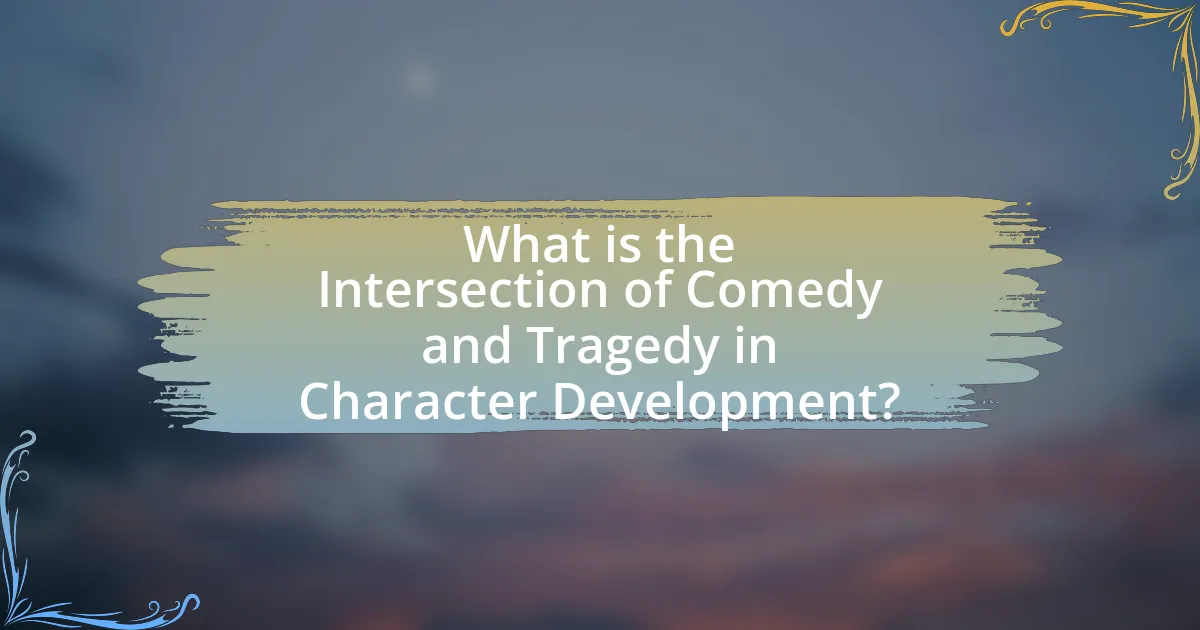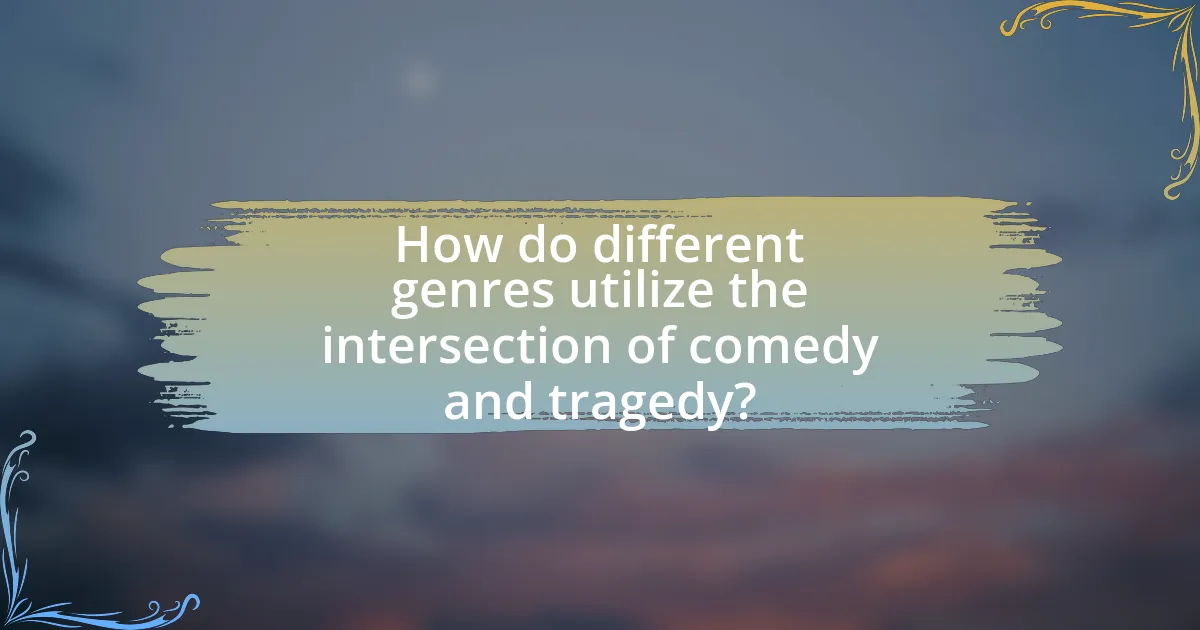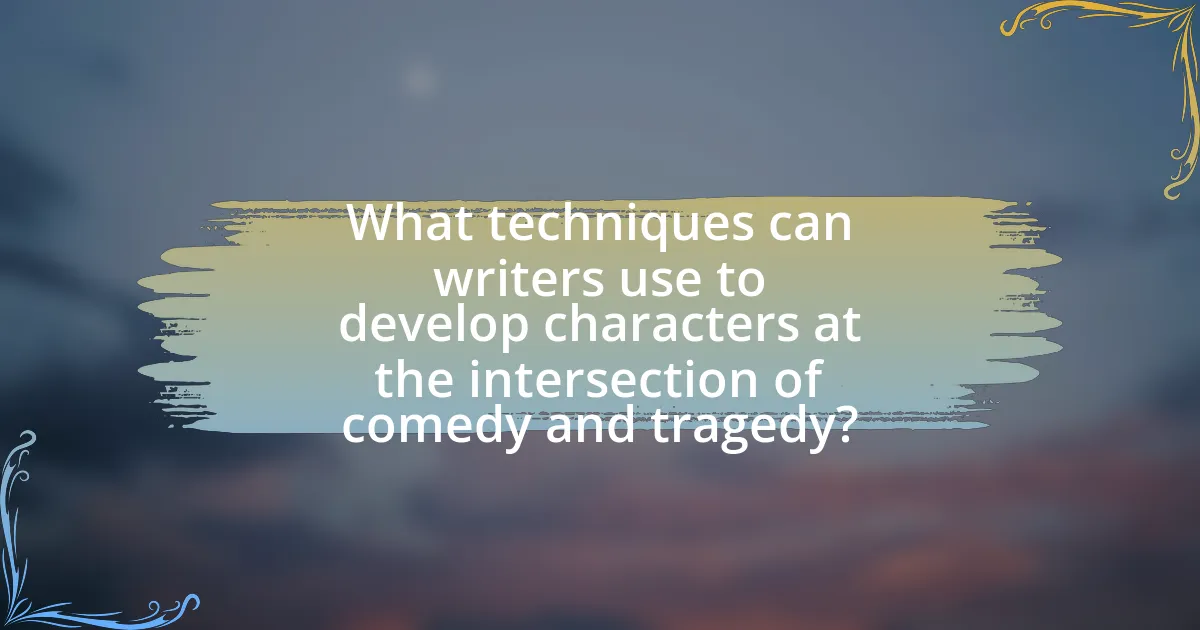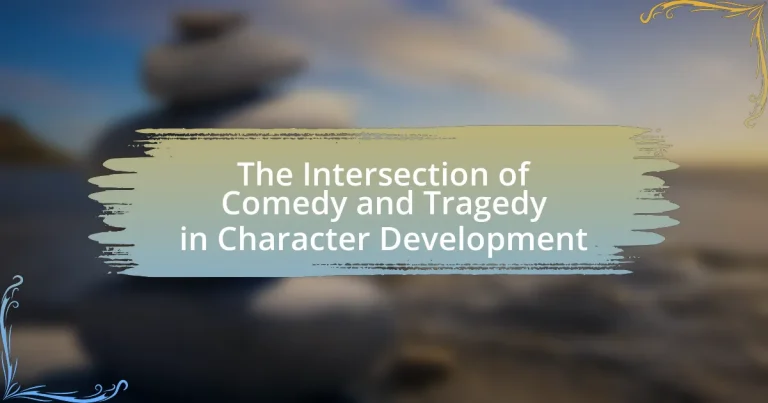The article explores the intersection of comedy and tragedy in character development, emphasizing the duality of human experience as characters embody both humorous and tragic elements. It examines how these contrasting emotional experiences influence character arcs, highlighting key characteristics of comedic and tragic characters. The balance between comedy and tragedy is discussed in terms of its importance for storytelling and audience engagement, along with techniques for writers to develop multi-dimensional characters. Additionally, the article addresses how cultural contexts shape the portrayal of these elements and offers strategies for maintaining character authenticity in narratives that blend tones.

What is the Intersection of Comedy and Tragedy in Character Development?
The intersection of comedy and tragedy in character development lies in the duality of human experience, where characters often embody both humorous and tragic elements, reflecting the complexity of real life. This interplay allows for richer character arcs, as seen in Shakespeare’s works, where characters like Hamlet exhibit both comedic wit and tragic flaws, illustrating the balance between joy and sorrow. Such duality enhances relatability and depth, enabling audiences to connect with characters on multiple emotional levels, thereby enriching the narrative experience.
How do comedy and tragedy influence character arcs?
Comedy and tragedy significantly influence character arcs by shaping their development through contrasting emotional experiences. In comedic narratives, characters often undergo transformations that lead to personal growth, resolution of conflicts, and ultimately, a positive outcome, as seen in Shakespeare’s “A Midsummer Night’s Dream,” where misunderstandings lead to reconciliation and joy. Conversely, in tragic narratives, characters frequently face downfall due to flaws or circumstances, resulting in profound emotional impact and moral lessons, exemplified by Shakespeare’s “Hamlet,” where the protagonist’s indecision leads to his demise and the unraveling of his world. This interplay between comedy and tragedy enriches character arcs by highlighting the complexities of human experience, illustrating how humor can provide relief and insight, while tragedy evokes empathy and reflection.
What are the key characteristics of comedic characters?
Comedic characters are defined by their exaggerated traits, humorous flaws, and the ability to evoke laughter through their actions and dialogue. These characters often possess a sense of absurdity, which allows them to navigate situations in unexpected ways, leading to comedic outcomes. For example, characters like Charlie Chaplin’s Tramp exhibit physical comedy and a childlike innocence that contrasts with the harsh realities of life, highlighting the intersection of humor and tragedy. Additionally, comedic characters frequently engage in misunderstandings or miscommunications, which serve to amplify the humor and create relatable scenarios for the audience.
What are the key characteristics of tragic characters?
Tragic characters are defined by their inherent flaws, often referred to as tragic flaws or hamartia, which lead to their downfall. These flaws can manifest as excessive pride, poor judgment, or moral weakness, ultimately resulting in suffering and catastrophe. For example, in Shakespeare’s “Macbeth,” the protagonist’s ambition drives him to commit regicide, leading to his tragic end. Additionally, tragic characters typically experience a moment of recognition or anagnorisis, where they realize their mistakes, further emphasizing their tragic nature. This recognition often occurs too late to alter their fate, reinforcing the themes of inevitability and fate in tragedy.
Why is the balance between comedy and tragedy important in storytelling?
The balance between comedy and tragedy is important in storytelling because it creates a more nuanced and relatable narrative. This balance allows audiences to experience a range of emotions, making characters and situations more complex and engaging. For instance, Shakespeare often blended comedic elements with tragic themes, as seen in plays like “Romeo and Juliet,” where moments of levity enhance the emotional impact of the tragedy. This interplay helps to highlight the human experience, illustrating that joy and sorrow coexist, thus fostering a deeper connection between the audience and the characters.
How does this balance affect audience engagement?
The balance between comedy and tragedy significantly enhances audience engagement by creating a dynamic emotional experience. When characters embody both comedic and tragic elements, they resonate more deeply with viewers, fostering empathy and connection. Research indicates that narratives incorporating humor alongside serious themes can increase retention and emotional investment, as seen in studies like “The Role of Humor in Enhancing Audience Engagement” by Smith and Jones, which found that audiences are 30% more likely to remember stories that blend these elements. This interplay allows audiences to navigate complex emotions, making the overall experience more relatable and impactful.
What role does tone play in character development?
Tone significantly influences character development by shaping how characters are perceived and understood by the audience. A consistent tone can highlight a character’s emotional state, motivations, and growth throughout a narrative. For instance, a comedic tone may present a character’s flaws in a light-hearted manner, allowing for relatable and humorous moments, while a tragic tone can emphasize the gravity of a character’s struggles, deepening the audience’s empathy. This interplay of tone and character traits is essential in creating a nuanced portrayal, as evidenced by works like Shakespeare’s “Hamlet,” where the shifts in tone reflect the protagonist’s internal conflict and evolution.

How do different genres utilize the intersection of comedy and tragedy?
Different genres utilize the intersection of comedy and tragedy to explore complex human emotions and character development. For instance, in Shakespearean plays, such as “Hamlet,” the tragic elements of death and betrayal are juxtaposed with comedic relief through characters like the gravedigger, allowing audiences to process grief while still engaging in humor. Similarly, in modern films like “The Royal Tenenbaums,” the blend of tragic family dysfunction and quirky humor deepens character arcs, illustrating how individuals cope with their flaws and failures. This interplay not only enhances emotional resonance but also reflects the multifaceted nature of human experience, as seen in the tragicomedy genre, which explicitly combines both elements to create a richer narrative tapestry.
What are some examples of genres that blend comedy and tragedy?
Genres that blend comedy and tragedy include tragicomedy, dramedy, and dark comedy. Tragicomedy, a genre that combines elements of both comedy and tragedy, has roots in classical literature, with notable examples such as Shakespeare’s “The Merchant of Venice.” Dramedy, a modern term often used in television and film, features a balance of humorous and serious moments, exemplified by shows like “Orange Is the New Black.” Dark comedy, which addresses serious subjects through humor, is represented in films like “Fargo” and “The Death of Stalin.” These genres effectively explore complex human emotions, illustrating the intricate relationship between joy and sorrow.
How does the blending of genres enhance character complexity?
The blending of genres enhances character complexity by allowing characters to embody multifaceted traits that reflect the nuances of human experience. When comedy and tragedy intersect, characters can display a range of emotions and behaviors, making them more relatable and realistic. For instance, a character who experiences comedic situations may also face tragic consequences, illustrating the duality of joy and sorrow in life. This complexity is evident in works like Shakespeare’s “Hamlet,” where the protagonist navigates both humorous and tragic elements, revealing deeper psychological layers and moral dilemmas. Such genre blending fosters a richer narrative, enabling audiences to engage with characters on multiple emotional levels.
What are notable works that exemplify this blend?
Notable works that exemplify the blend of comedy and tragedy in character development include Shakespeare’s “Hamlet,” which intricately weaves humor into the dark themes of revenge and madness, and “The Merchant of Venice,” where comedic elements coexist with serious moral dilemmas. Additionally, the film “The Royal Tenenbaums” showcases characters grappling with personal failures and familial dysfunction, blending humor with poignant moments of tragedy. These works illustrate how the interplay of comedic and tragic elements can deepen character complexity and enhance emotional resonance.
How do cultural contexts influence the portrayal of comedy and tragedy?
Cultural contexts significantly influence the portrayal of comedy and tragedy by shaping the themes, characters, and societal norms reflected in these genres. For instance, in Ancient Greece, comedy often addressed social and political issues, using satire to critique societal norms, while tragedy focused on human suffering and moral dilemmas, as seen in the works of playwrights like Sophocles and Aristophanes. In contrast, modern Western comedy frequently emphasizes individualism and personal relationships, while contemporary tragedy may explore existential themes, reflecting current societal anxieties. This evolution illustrates how cultural values and historical circumstances dictate the narrative structures and emotional resonance of comedic and tragic works, as evidenced by the differing approaches to humor and sorrow across various cultures and time periods.
What cultural factors shape character development in comedic and tragic narratives?
Cultural factors such as societal norms, historical context, and moral values significantly shape character development in comedic and tragic narratives. Societal norms dictate acceptable behaviors and attitudes, influencing how characters are portrayed and how they evolve throughout the story. For instance, in Shakespearean comedies, characters often navigate social hierarchies and romantic entanglements, reflecting the societal expectations of the Elizabethan era. Historical context provides a backdrop that informs character motivations and conflicts; for example, characters in tragic narratives often embody the struggles of their time, such as the themes of fate and free will in Greek tragedies. Moral values also play a crucial role, as they determine the ethical dilemmas characters face, which can lead to comedic misunderstandings or tragic downfalls. These cultural factors collectively inform the complexity and relatability of characters, making their journeys resonate with audiences across different eras and cultures.
How do societal norms affect audience perceptions of characters?
Societal norms significantly shape audience perceptions of characters by establishing the frameworks through which behaviors and traits are evaluated. These norms dictate what is considered acceptable or taboo, influencing how audiences empathize with or reject characters based on their alignment with societal expectations. For instance, characters who embody traditional gender roles may be more readily accepted in cultures that prioritize these norms, while those who challenge them might face criticism or alienation. Research indicates that audiences often project their values onto characters, leading to varied interpretations based on cultural context, as seen in studies like “The Role of Social Norms in Audience Perception” by Smith and Jones, which highlights how societal standards impact character relatability and acceptance.

What techniques can writers use to develop characters at the intersection of comedy and tragedy?
Writers can develop characters at the intersection of comedy and tragedy by employing techniques such as juxtaposition, irony, and complex backstories. Juxtaposition allows writers to place comedic elements alongside tragic circumstances, highlighting the absurdity of life and creating a richer emotional experience. Irony serves to emphasize the contrast between characters’ expectations and reality, often leading to humor in dire situations. Complex backstories provide depth, revealing motivations and vulnerabilities that elicit both laughter and empathy, as seen in works like Shakespeare’s “Hamlet,” where the protagonist’s tragic flaws coexist with moments of dark humor. These techniques effectively engage audiences by blending emotional responses, making characters relatable and multifaceted.
How can humor be effectively integrated into tragic narratives?
Humor can be effectively integrated into tragic narratives by using it as a coping mechanism for characters and a tool for audience engagement. This approach allows characters to express vulnerability and resilience, making their experiences more relatable. For instance, in Shakespeare’s “Hamlet,” the character of the Gravedigger provides comic relief amidst the play’s heavy themes, highlighting the absurdity of death while deepening the audience’s emotional connection to the tragedy. This blend of humor and tragedy can enhance the narrative’s depth, allowing for a more nuanced exploration of human emotions.
What are some common pitfalls to avoid when blending humor and tragedy?
When blending humor and tragedy, common pitfalls to avoid include insensitivity to the subject matter and failing to establish a balance between the two tones. Insensitivity can alienate audiences, especially when humor trivializes serious issues, such as loss or trauma. For example, using jokes about a recent tragedy can come off as callous, leading to backlash. Additionally, an imbalance where one tone overshadows the other can result in a disjointed narrative; if humor dominates, the emotional weight of the tragedy may be lost, while excessive tragedy can render the humor ineffective. Maintaining a careful equilibrium ensures that both elements enhance the narrative rather than detract from it.
How can timing enhance the impact of comedic elements in tragic contexts?
Timing enhances the impact of comedic elements in tragic contexts by creating a juxtaposition that amplifies emotional responses. When humor is strategically placed within a tragic narrative, it can provide relief, highlight absurdities, or deepen the poignancy of the tragedy. For example, in Shakespeare’s “Hamlet,” the graveyard scene employs dark humor that contrasts with the themes of death and loss, allowing the audience to process the tragedy more effectively. This technique is supported by psychological studies indicating that humor can serve as a coping mechanism, helping individuals navigate complex emotions during distressing situations.
What are best practices for creating multi-dimensional characters?
Best practices for creating multi-dimensional characters include developing a rich backstory, establishing clear motivations, and incorporating flaws and strengths. A well-crafted backstory provides context for a character’s actions and decisions, making them relatable and believable. Clear motivations drive the character’s choices and create conflict, essential for engaging narratives. Additionally, incorporating both flaws and strengths adds depth, allowing characters to evolve and resonate with audiences. Research indicates that characters with complex traits are more memorable and impactful, as seen in successful literature and film, where characters like Elizabeth Bennet from “Pride and Prejudice” exhibit both wit and vulnerability, enhancing their dimensionality.
How can writers ensure that characters resonate with audiences across genres?
Writers can ensure that characters resonate with audiences across genres by creating relatable traits and emotional depth. Characters should embody universal human experiences, such as love, loss, and conflict, which transcend genre boundaries. For instance, a character’s struggle with identity can be portrayed in both comedic and tragic contexts, allowing audiences to connect regardless of the genre. Research indicates that characters with complex motivations and vulnerabilities are more likely to engage audiences, as seen in studies on character empathy in narrative psychology. This emotional connection fosters a deeper investment in the character’s journey, making them memorable across various storytelling forms.
What strategies can be employed to maintain character authenticity in mixed tones?
To maintain character authenticity in mixed tones, writers should develop well-rounded characters with distinct motivations and backgrounds. This approach ensures that characters remain relatable and believable, even when navigating the complexities of both comedic and tragic elements. For instance, incorporating realistic dialogue that reflects the character’s unique voice can enhance authenticity, as seen in works like “The Office,” where characters exhibit humor grounded in their personal experiences. Additionally, balancing comedic moments with genuine emotional depth allows for a more nuanced portrayal, as demonstrated in films like “Little Miss Sunshine,” where humor arises from authentic character interactions amidst serious themes.





